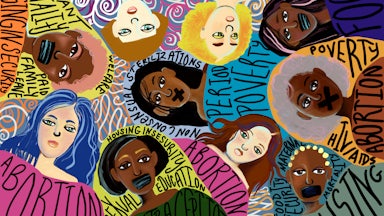When the Supreme Court overturned Roe v. Wade in June, it shook the country in ways that I don’t think anyone fully anticipated. Ahead of the decision, it was easy to point to data saying that most people and health professionals thought the procedure should be fully legal. But after the decision, there was no longer any room for doubt about what the people truly wanted.
In the six months since, time and time again, Republicans have tried to clamp down on abortion access. And time after time, even in the reddest of states, they are shown just how wrong they are.
The court ruling had been building for a while. Republican-led states had been implementing increasingly restrictive abortion legislation, from Mississippi to Ohio and Texas with its horrific vigilante law.
The majority of Americans—61 percent—disagreed with such restrictions, according to a Pew Research Center study. Health care professionals warned that limiting reproductive rights would cause maternal mortality to skyrocket.
Even economists weighed in: Treasury Secretary Janet Yellen testified before Congress that outlawing abortion would have a crippling effect on women’s earning ability and economic mobility.
After the ruling, there was devastation—but also something like a rebellion.
At first, only the bad things came to light: Abortion clinics, often the only places offering any kind of reproductive health care for an entire region, had to close. A 10-year-old had to travel out of Ohio for an abortion after she was raped, because her state’s trigger laws prohibited the procedure after six weeks. The right wing, including Indiana’s Republican state attorney general, began attacking the doctor who provided the child with abortion medication.
States that still had abortion access soon found themselves overwhelmed. Within a few months, wait times at abortion clinics in Colorado, where the procedure is legal, had doubled. People rushed to get birth control, to stock up on emergency contraception, even to sterilize themselves. They considered moving out of their state or the country.
But also, people stepped up. The country had been swept by protests since the spring, when the Supreme Court draft decision leaked.
In the months that followed the official ruling, thousands of people protested across the country, demanding the federal government do more to protect their rights.
Another Pew study found that 57 percent of people disapproved of the Supreme Court ruling. They were quick to put their money where their mouths are.
Abortion funds were flooded with donations. TikTok was awash with videos of people offering their homes and their cars to anyone who might need to travel for an abortion.
And then came Kansas. In August, during the state’s midterm primary, residents also voted on whether to keep language in the state constitution that would protect abortion access. In a state that has consistently voted Republican in the last 14 presidential elections, an overwhelming 59 percent voted to keep the pro-abortion language.
Somehow, that didn’t seem to be a loud enough rebuke of the ruling: Senator Lindsey Graham still tried in September to introduce a federal ban on abortion after 15 weeks.
Over the next two months, people showed him just how badly he had read the room. Record numbers of women registered to vote, many of them citing the Supreme Court ruling as the reason why. Democrats campaigned ahead of the midterms on abortion access, despite critics saying they could never win races on social issues.
During the midterms, 27 percent of voters said abortion was one of their top issues. Five states had abortion access measures on the ballot in November: deep blue states California and Vermont, swing state Michigan, and red states Kentucky and Montana. Residents of all five voted to either keep or expand reproductive rights.
In Michigan, Governor Gretchen Whitmer had campaigned aggressively on abortion access. Not only did she handily beat her Trump-backed opponent, but her Democratic Party also flipped the state legislature for the first time in almost 40 years. Democrats flipped a Pennsylvania Senate seat and the state legislature as well.
And a week before Thanksgiving, a judge in Georgia struck down the state’s abortion law, calling it “plainly unconstitutional.”
But it’s still hard to view all of this as a victory. State-level wins will never help as many people as a federal law, and they’re easier to challenge. A week after the Georgia law was blocked, the state Supreme Court reinstated it.
It has long been my belief that reproductive rights in the United States have generally always been a scam, because they’re not really about rights or privacy. They’re about power, and who gets to have it. They’ve never actually given people with uteruses full autonomy, just incrementally more control to see if this time, we’ll finally shut up.
Prior to Roe, single people weren’t even allowed to use contraception. Until 1972, that right was restricted to married people. After the Roe ruling, the government was still allowed to restrict abortion access based on the stage of the pregnancy.
And this created a loophole that countless states and institutions exploited to force people to keep their pregnancies. Even before Roe was officially overturned, activists had long warned that it was headed out the door, as abortion rights were sharply curtailed through a growing network of restrictions.
People had to get permission from their parents, their partner, or whoever impregnated them; they had to listen to the fetal heartbeat or see a sonogram. They had to wait a certain amount of time, ostensibly to reflect on their choices but really to simply run out the clock on when they could get an abortion.
Sometimes the nearest abortion clinic wasn’t actually all the close, and they had to figure out a way to travel across or even out of their state. Sometimes the only abortion clinic in a region was shut down, for reasons such as its hallways being deemed too narrow.
The continued presence of the government in abortion regulations—and before Roe, the requirement to be married—meant that someone who would not have to carry the pregnancy had final say. It said that someone else supposedly knows better, while the person who is or might get pregnant doesn’t know themselves well enough to make the decision on their own.
Abortions are not decisions made lightly. No one gets an abortion just for fun. The decision to get an abortion is made when there is no other option.
But there are still people in power who think they know better. They think they know more. And for the time being, they’re still the ones with the last word.










